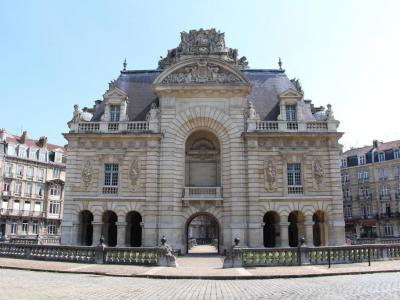
Porte de Paris (Paris Gate), Lille
Louis XIV of France thought the dowry of his bride, Maria Theresa of Austria, wasn't paid. And furthermore, bits of Flanders controlled by Spain should be his. The result was the War of Devolution and the siege of Lille in 1668. Louis attacked, and in 18 days the city was his.
Louis entered the city in triumph. He paraded through the Gate of the Sick (Porte des Malades), and received the keys of the city from the Magistrate. Louis had plans for Lille and the Gate of the Sick.
Louis quickly commissioned architect Simon Vollant to build the Paris Gate. It was finished in 1692, a monument to Louis and the annexing of Lille. The Paris Gate was erected in front of a guardhouse built on the site of the Gate of the Sick. In 1860 the guardhouse was demolished along with the city fortifications.
In 1895 the Paris Gate was redeveloped by architect Louis-Marie Cordonnier. Monsieur Cordonnier created a facade on the city side and renovated the surrounding Simon-Vollant Square. The result is two different facades.
The Paris Gate is an Arch of Triumph. On top two angels proclaim the victory of Louis XIV. On the left is a sculpture of Mars, god of war. On the right, Hercules stands, a symbol of strength. Allegorical figures of "Fame" and "Victory" make ready to crown the King. A draw bridge at ground level leads to a vaulted hall that opens to the city.
Louis entered the city in triumph. He paraded through the Gate of the Sick (Porte des Malades), and received the keys of the city from the Magistrate. Louis had plans for Lille and the Gate of the Sick.
Louis quickly commissioned architect Simon Vollant to build the Paris Gate. It was finished in 1692, a monument to Louis and the annexing of Lille. The Paris Gate was erected in front of a guardhouse built on the site of the Gate of the Sick. In 1860 the guardhouse was demolished along with the city fortifications.
In 1895 the Paris Gate was redeveloped by architect Louis-Marie Cordonnier. Monsieur Cordonnier created a facade on the city side and renovated the surrounding Simon-Vollant Square. The result is two different facades.
The Paris Gate is an Arch of Triumph. On top two angels proclaim the victory of Louis XIV. On the left is a sculpture of Mars, god of war. On the right, Hercules stands, a symbol of strength. Allegorical figures of "Fame" and "Victory" make ready to crown the King. A draw bridge at ground level leads to a vaulted hall that opens to the city.
Want to visit this sight? Check out these Self-Guided Walking Tours in Lille. Alternatively, you can download the mobile app "GPSmyCity: Walks in 1K+ Cities" from Apple App Store or Google Play Store. The app turns your mobile device to a personal tour guide and it works offline, so no data plan is needed when traveling abroad.
Porte de Paris (Paris Gate) on Map
Sight Name: Porte de Paris (Paris Gate)
Sight Location: Lille, France (See walking tours in Lille)
Sight Type: Attraction/Landmark
Guide(s) Containing This Sight:
Sight Location: Lille, France (See walking tours in Lille)
Sight Type: Attraction/Landmark
Guide(s) Containing This Sight:
Walking Tours in Lille, France
Create Your Own Walk in Lille
Creating your own self-guided walk in Lille is easy and fun. Choose the city attractions that you want to see and a walk route map will be created just for you. You can even set your hotel as the start point of the walk.
Lille Introduction Walking Tour
Nicknamed in France the "Capital of Flanders", Lille and its surroundings belong to the historical region of Romance Flanders. Legend has it that in 620 AD, Salvaert, Prince of Dijon, passed through the region with his pregnant wife when he was attacked and killed by the local lord Phinaert The Giant. Years later, his son Lyderic avenged his father by killing the Giant and founded the... view more
Tour Duration: 2 Hour(s)
Travel Distance: 4.0 Km or 2.5 Miles
Tour Duration: 2 Hour(s)
Travel Distance: 4.0 Km or 2.5 Miles
Lille's Historical Buildings Tour
Historically, Lille's architecture differs from that of other French cities. Prior to being invaded by Louis XIV in 1667, Lille was Flemish, which is evident in its red-brick and other structures, quite uncommon for the rest of France.
Among many things, Lille is reputed for its fabulous historic center, abounding in time-honored buildings, palaces, and churches, offering a great deal of... view more
Tour Duration: 2 Hour(s)
Travel Distance: 3.7 Km or 2.3 Miles
Among many things, Lille is reputed for its fabulous historic center, abounding in time-honored buildings, palaces, and churches, offering a great deal of... view more
Tour Duration: 2 Hour(s)
Travel Distance: 3.7 Km or 2.3 Miles


